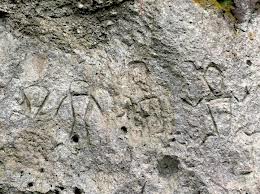Putting money where our mouth is
 NEW YORK, New York—I was astounded to learn that in the town of Binangonan, barely 90 miles from Manila, is a trove of cave drawings that are believed to be 5,000 years old, and that these drawings carved on stone, or petroglyphs, were first stumbled upon in 1965 by Carlos “Botong” Francisco when he was leading a Boy Scout troop on a hike. It’s fitting that it was a muralist, justly praised for his work, who came upon these artifacts. (Botong, named National Artist posthumously in 1973, was from Angono, not far from the cave site.) The human figures depicted in these drawings are thought to be in positions that imply acts of worship.
NEW YORK, New York—I was astounded to learn that in the town of Binangonan, barely 90 miles from Manila, is a trove of cave drawings that are believed to be 5,000 years old, and that these drawings carved on stone, or petroglyphs, were first stumbled upon in 1965 by Carlos “Botong” Francisco when he was leading a Boy Scout troop on a hike. It’s fitting that it was a muralist, justly praised for his work, who came upon these artifacts. (Botong, named National Artist posthumously in 1973, was from Angono, not far from the cave site.) The human figures depicted in these drawings are thought to be in positions that imply acts of worship.
That means the existence of these petroglyphs has been known to contemporary Philippine society for almost half a century. Yet I don’t recall reading or hearing anything about these, whether in guidebooks, tourist brochures, or historical tomes. I don’t know anyone who has visited the site. One would have thought that the Marcos regime, in power when these stone carvings were first announced to the world, would have promoted these at every turn, as proof positive that there was a society and a culture long before the arrival of the West in the form of the Spanish colonizers. But perhaps these clues to our ancient history were not sexy or glamorous enough for the couple, more interested in fake war medals (in his case) and European artworks (in hers), though they could have presented these drawings in a way that strengthened their own self-mythologizing as Malakas and Maganda.
If the drawings were indeed five millennia old—which would date them to the Stone Age—they would certainly be among the oldest, if not the oldest, known artworks discovered in the archipelago, though not the oldest artifacts. For now, that distinction belongs to the Tabon Cave in Palawan and its contents, dating back 50,000 years ago to the Pleistocene Age and continuously inhabited until 9,000 BCE.
The dating of the Binangonan petroglyphs is an educated guestimate, since the National Museum, under whose jurisdiction the artworks fall, lacks the funding to have them carbon-dated. Instead, the museum scientists base their calculations on the type of tools and pottery shards found in the cave, which are typical of the Stone Age.
While these cave drawings have been declared a national treasure, they are hardly treated as such. They are in danger of disappearing because of the lack of funds to preserve them. It’s true that UNESCO has included the cave drawings on the list of possible World Heritage Sites, and that the World Monuments Fund, a New York-based organization, has helped in their preservation. But the national government needs to step in and provide most of the funding to make sure that the encroachments on the site—housing, traffic, deforestation, the carbon footprints of visitors, even vandalism—be severely diminished, if not completely eliminated (which would likely be impossible, in any case).
One solution is to create a replica nearby, of the cave and its art, to keep the original site intact, and still allow visitors to get a vivid and realistic sense of the petroglyphs, just not at the site itself. This has been done, for instance, in the case of the Lascaux caves, in southwestern France, whose Paleolithic cave paintings are 17,300 years old. And even then the original site has been plagued by fungus and a black mold.
The national government has to step up and preserve this vital link to our past. The usual excuse of not having enough funds will be proffered. But that is all that this is: an excuse. The government has discretionary funds, otherwise known as pork barrel. Though there has been a public outcry over such funds, this has been mainly directed at the pork barrel made available to legislators. And surely the congressperson within whose district Binangonan falls can take steps to help in the preservation of the petroglyphs. Certainly the principle of eminent domain can be invoked to obtain more land within which to create both the replica and a buffer zone that could include amenities such as a gift shop and a restaurant/café. In short, with the proper management and vision, preserving the cave and its artistic testament to the durability and visions of the human spirit, can lead to the creation of jobs and at the same time generate enough income to pay for its maintenance.
I say this knowing that the national government’s attitude towards the country’s patrimony is inconsistent if not lackadaisical. I’d be interested to know how the Cultural Center of the Philippines and the National Commission on Culture and the Arts deal with such matters. How many historical sites are left untended? Commemorative plaques are good first step but hardly sufficient. As the Tagalog proverb says, ang hindi lumilingon sa pinanggalingan ay hindi makakarating sa paroroonan (She who doesn’t know her roots will never arrive at her destination).
It’s time to put our money where our mouth is.
Copyright L.H. Francia 2014
RELATED STORIES
Ancient enigmatic carvings in danger of disappearing
In search of Angono’s art treasures














